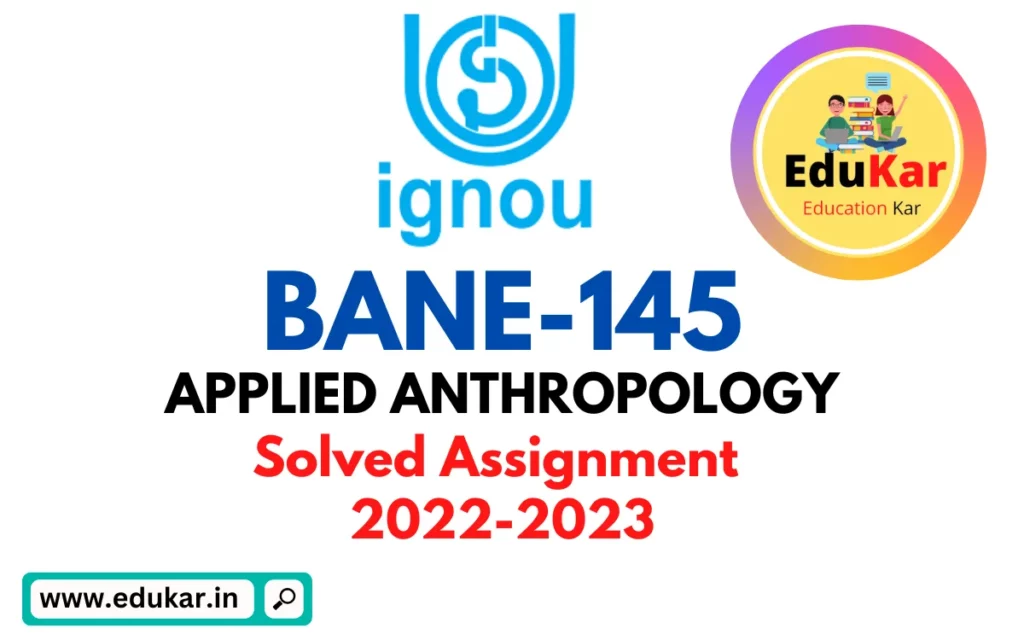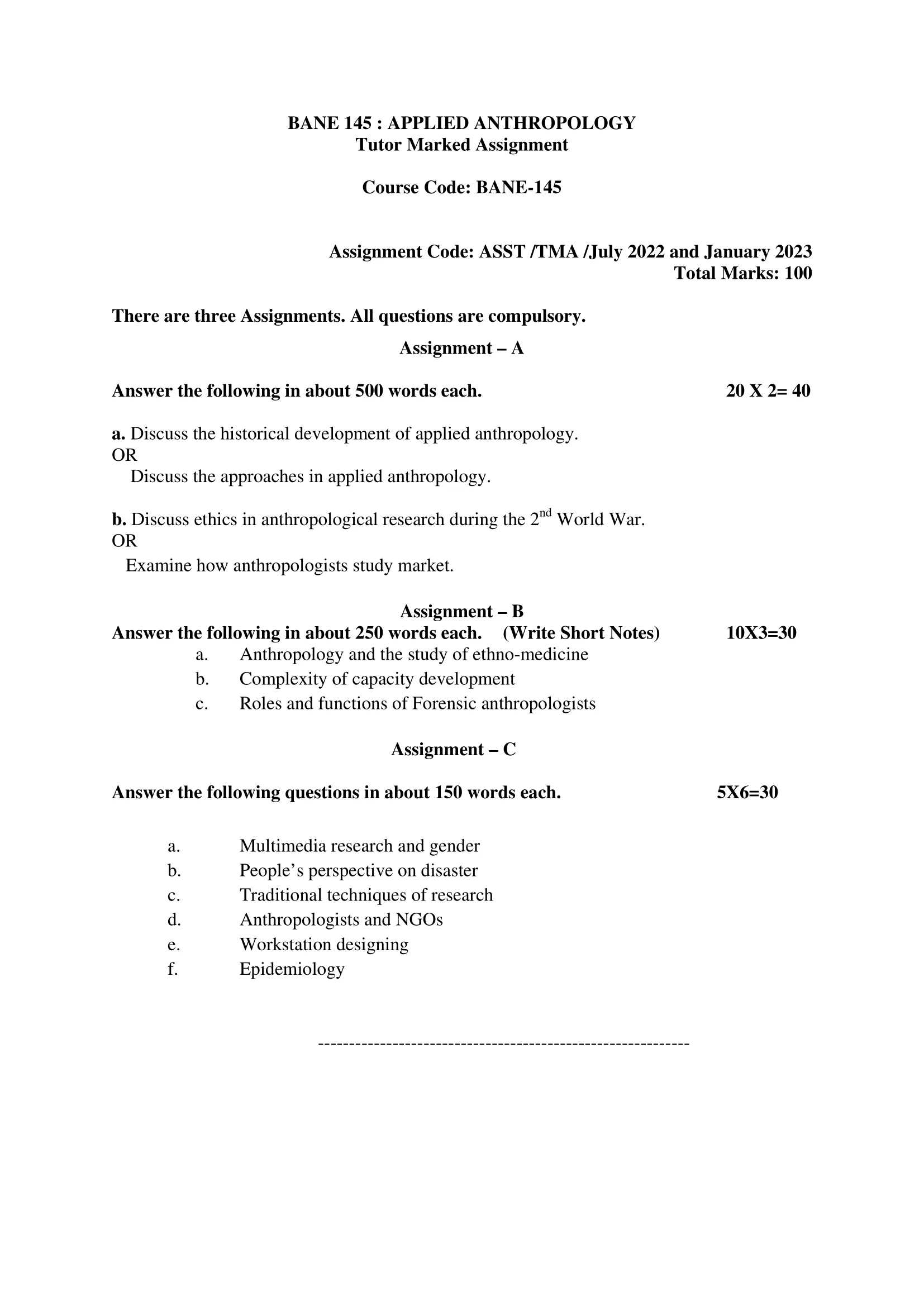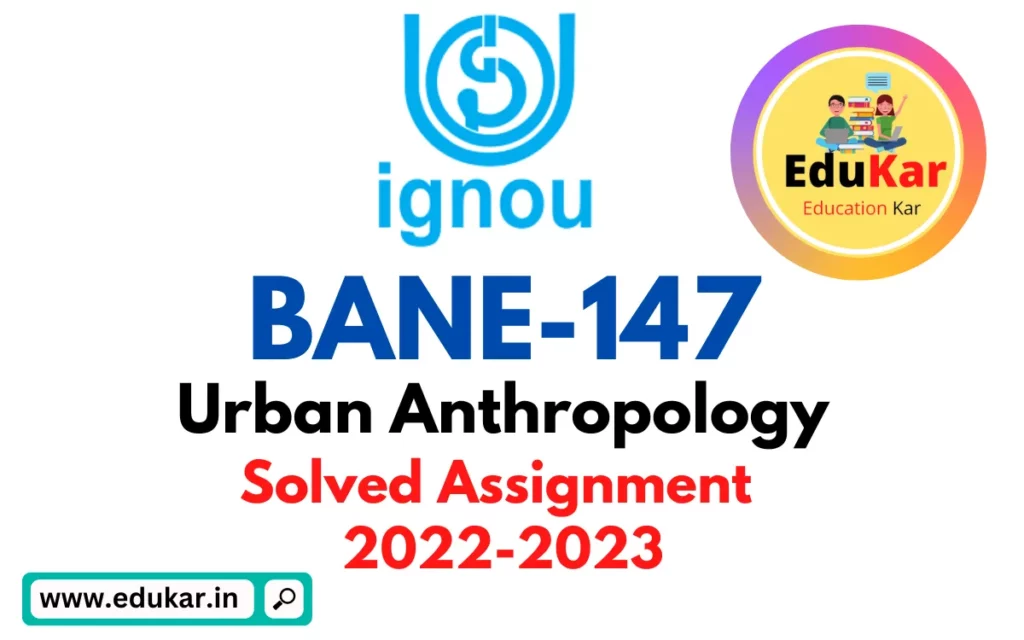Contents
- 1 Assignment – A
- 2 Answer the following in about 500 words each. 20 X 2= 40
- 3 a. Discuss the historical development of applied anthropology.
- 4 Discuss the approaches in applied anthropology.
- 5 b. Discuss ethics in anthropological research during the 2nd World War.
- 6 Examine how anthropologists study market.
- 7 Assignment – B
- 8 Answer the following in about 250 words each. (Write Short Notes) 10X3=30
- 9 a. Anthropology and the study of ethno-medicine
- 10 b. Complexity of capacity development
- 11 c. Roles and functions of Forensic anthropologists
- 12 Assignment – C
- 13 Answer the following questions in about 150 words each. 5X6=30
- 14 a. Multimedia research and gender
- 15 b. People’s perspective on disaster
- 16 c. Traditional techniques of research
- 17 d. Anthropologists and NGOs
- 18 e. Workstation designing
- 19 f. Epidemiology

| Title | BANE-145: IGNOU BAG Solved Assignment 2022-2023 |
| University | IGNOU |
| Degree | Bachelor Degree Programme |
| Course Code | BANE-145 |
| Course Name | APPLIED ANTHROPOLOGY |
| Programme Name | Bachelor of Arts (General) |
| Programme Code | BAG |
| Total Marks | 100 |
| Year | 2022-2023 |
| Language | English |
| Assignment Code | ASST /TMA /July 2022 and January 2023 |
| Last Date for Submission of Assignment: | For June Examination: 31st April For December Examination: 30th September |

Assignment – A
Answer the following in about 500 words each. 20 X 2= 40
a. Discuss the historical development of applied anthropology.
Ans: Applied anthropology is a subfield of anthropology that focuses on the practical application of anthropological theories, methods, and knowledge to solve real-world problems. The field has a long and rich history that spans several decades and has its roots in early 20th century social reform movements.
The early 20th century was a time of great change and progress in many fields, including anthropology. Anthropologists of this era were interested in understanding the ways in which different cultures lived and interacted with one another. Some of the most famous anthropologists of this time, such as Franz Boas, conducted groundbreaking research on the cultures of indigenous peoples in North America, South America, and elsewhere.
However, as the field of anthropology matured, many anthropologists began to see the limitations of pure academic research. They recognized that they could use their knowledge and skills to address some of the most pressing social, economic, and political issues facing society. This led to the emergence of applied anthropology in the 1920s and 1930s.
One of the first examples of applied anthropology was the work of anthropologists in the American Southwest, who worked with the Hopi and Navajo tribes to improve their health and welfare. These anthropologists applied their understanding of cultural practices and beliefs to develop programs that would be most effective in addressing the health needs of these communities.
In the 1950s and 1960s, applied anthropology expanded to include a broader range of topics and issues. Anthropologists began to apply their knowledge to the fields of development, environmental management, and social planning. For example, in the field of development, anthropologists helped to design and implement programs that improved the lives of people in poor communities around the world.
One of the most important developments in the history of applied anthropology was the establishment of interdisciplinary programs in universities. These programs brought together anthropologists, sociologists, economists, and other social scientists to work on complex social problems. This interdisciplinary approach helped to ensure that applied anthropology would have a greater impact on society, as it drew on the strengths of multiple disciplines to solve real-world problems.
In the 1980s and 1990s, applied anthropology became even more mainstream and widely recognized as a valuable tool for addressing social problems. During this time, the field expanded to include a wider range of issues, such as human rights, environmental justice, and global health. Anthropologists also began to play a more active role in public policy and advocacy, working with government agencies, non-government organizations, and community groups to address social and environmental issues.
Today, applied anthropology is an established field of study with a rich history of contributions to society. Anthropologists continue to work on a wide range of issues, using their knowledge of cultural practices, beliefs, and behaviors to help solve some of the most pressing problems facing society.
OR
Discuss the approaches in applied anthropology.
Ans: Applied anthropology is a subfield of anthropology that focuses on the practical application of anthropological theories, methods, and knowledge to address real-world problems. There are several different approaches to applied anthropology, each of which emphasizes different aspects of the discipline and provides different strategies for solving problems.
The first approach in applied anthropology is the participatory approach. This approach emphasizes the importance of collaboration between anthropologists and the communities they study. Anthropologists work with communities to understand their needs and perspectives and to develop solutions that are culturally appropriate and sustainable. This approach is particularly useful in development projects, where the goal is to improve the lives of people in poor communities.
The second approach in applied anthropology is the problem-solving approach. This approach is based on the idea that anthropologists can use their knowledge of cultural practices and beliefs to address specific problems facing communities. For example, anthropologists might use their knowledge of cultural beliefs about health to develop effective health promotion programs or to design culturally appropriate interventions to address specific health problems.
The third approach in applied anthropology is the advocacy approach. This approach emphasizes the role of anthropologists as advocates for the rights and well-being of the communities they study. Anthropologists using this approach may work with government agencies, non-government organizations, or community groups to raise awareness about specific issues and to advocate for policy changes that will benefit communities.
The fourth approach in applied anthropology is the empowerment approach. This approach is based on the idea that communities are best equipped to solve their own problems when they are empowered with the knowledge and skills they need to do so. Anthropologists using this approach may work with communities to develop programs that promote self-sufficiency and community empowerment. For example, they may help communities to develop their own health promotion programs or to design and implement community-based conservation initiatives.
The fifth approach in applied anthropology is the critical approach. This approach emphasizes the importance of understanding the social, economic, and political forces that shape communities and the problems they face. Anthropologists using this approach may use their knowledge of cultural practices and beliefs to critique social and political structures that contribute to poverty, inequality, and other forms of social injustice.
Each of these approaches has its strengths and weaknesses, and the most effective applied anthropology projects often use a combination of these approaches. For example, a development project might use a participatory approach to engage communities in the design and implementation of the project, a problem-solving approach to address specific development needs, and an empowerment approach to promote community self-sufficiency.
b. Discuss ethics in anthropological research during the 2nd World War.
Ans: The Second World War was a period of intense political, social, and cultural upheaval that had a profound impact on the field of anthropology and the way in which anthropologists conducted research. During this period, the ethical considerations that guided anthropological research were greatly influenced by the political and military context in which research was conducted.
One of the most significant ethical issues facing anthropologists during the Second World War was the question of collaboration with military and government organizations. Many anthropologists were employed by government agencies or military organizations to conduct research that would support their war efforts. This collaboration often involved conducting research on populations that were targeted by the military or were in conflict with the government. Anthropologists who collaborated with the military were often called upon to use their skills and knowledge to support the war effort, which raised important questions about the ethics of using anthropological knowledge for military purposes.
Another ethical challenge facing anthropologists during the Second World War was the question of objectivity and impartiality. Anthropologists who conducted research during this period often found themselves in situations where they were asked to use their knowledge to support one side of a conflict or to provide intelligence that would help the military achieve its goals. This put anthropologists in a difficult ethical position, as they were expected to be impartial and objective in their research, but were also expected to support the war effort.
A third ethical challenge facing anthropologists during the Second World War was the question of informed consent. In many cases, anthropologists conducting research during this period were working in situations where individuals were not able to provide fully informed consent due to the political or military context. For example, anthropologists who were working with populations that were in conflict with the military often found it difficult to obtain consent from individuals who were living in fear of retribution from the military.
OR
Examine how anthropologists study market.
Ans: Market is a central aspect of human life and an important area of study for anthropologists. Anthropologists have long been interested in the ways in which markets function, the cultural and social processes that shape market behavior, and the impact of markets on communities and societies. Anthropologists study markets by using a variety of research methods, including participant observation, interviews, and surveys.
One approach to studying markets that is often used by anthropologists is the participant observation method. This method involves the anthropologist spending time in the market, observing and participating in market activities, and engaging in conversations with market participants. This allows the anthropologist to gain a detailed understanding of the market and the processes that shape market behavior. For example, an anthropologist might observe how prices are set, how goods are exchanged, and how relationships between buyers and sellers are formed.
Another approach to studying markets that is used by anthropologists is the use of interviews. Anthropologists often use interviews to gather information from market participants about their experiences and perspectives. This information can be used to understand the motivations and experiences of people who participate in the market and to identify the cultural and social factors that shape their behavior. For example, an anthropologist might conduct interviews with market vendors to understand their perspectives on the market and the challenges they face.
A third approach to studying markets that is used by anthropologists is the use of surveys. Surveys are a useful tool for gathering information from large numbers of people in a systematic and standardized way. Anthropologists often use surveys to gather data on market behavior and the economic, social, and cultural factors that shape market behavior. For example, an anthropologist might conduct a survey to gather data on the size and composition of the market, the types of goods and services that are traded, and the factors that influence prices.
Anthropologists also use a variety of theoretical frameworks to study markets. One of the most important of these frameworks is the political economy approach, which emphasizes the role of political and economic power in shaping market behavior. Anthropologists using this approach might focus on the ways in which government policies, trade agreements, and other forms of political and economic power influence market behavior and the distribution of resources.
Another important theoretical framework for studying markets is the cultural economics approach, which emphasizes the cultural and social factors that shape market behavior. Anthropologists using this approach might focus on the ways in which cultural beliefs, values, and norms influence market behavior and the ways in which markets shape cultural and social practices.
Assignment – B
Answer the following in about 250 words each. (Write Short Notes) 10X3=30
a. Anthropology and the study of ethno-medicine
Ans: Ethno-medicine is a subfield of anthropology that focuses on the study of traditional medical practices and beliefs in various cultures and societies. Ethno-medicine is concerned with understanding the ways in which people use plants, animals, and other natural resources to treat illnesses, as well as the cultural and social factors that shape these practices.
Anthropologists use a variety of research methods to study ethno-medicine, including participant observation, interviews, and surveys. By observing the use of traditional medical practices in communities and engaging in conversations with people who use these practices, anthropologists gain a deeper understanding of the cultural and social factors that shape these practices. Additionally, anthropologists use interviews and surveys to gather data on the use of traditional medical practices and to identify patterns in the ways in which people use these practices.
The study of ethno-medicine is important for several reasons. Firstly, traditional medical practices often offer unique and effective solutions to health problems that may not be available through conventional medicine. Secondly, the study of ethno-medicine provides insight into the ways in which people in different cultures and societies understand and experience health and illness. Thirdly, the study of ethno-medicine can inform the development of new medical treatments and practices that incorporate traditional medical knowledge and practices.
b. Complexity of capacity development
Ans: Capacity development refers to the process of improving the skills, knowledge, and abilities of individuals, organizations, and communities in order to achieve their goals and improve their well-being. While capacity development may seem straightforward, it is a complex process that involves a wide range of factors, including individual and organizational abilities, cultural and social context, and political and economic conditions.
One of the complexities of capacity development is the need to balance short-term and long-term goals. Capacity development may require short-term investments in training and other activities, but the benefits may not be realized until much later, after individuals, organizations, and communities have had time to develop their capacities and put their new skills and knowledge into practice. Additionally, capacity development may require individuals and organizations to make changes to the way they work, which can be difficult and require a significant investment of time and resources.
Another complexity of capacity development is the need to consider the cultural and social context in which capacity development is taking place. Cultural and social norms, values, and beliefs can influence the way individuals and organizations view capacity development and their willingness to participate in capacity development activities. Additionally, political and economic conditions can shape the availability of resources for capacity development and the opportunities for individuals and organizations to apply their new capacities.
Finally, the complexity of capacity development is also influenced by the interplay between individual and organizational capacities. Individuals and organizations may have different capacities and needs, and capacity development efforts must take these differences into account in order to be effective. Additionally, capacity development efforts must also be tailored to the specific needs and abilities of individuals, organizations, and communities, in order to ensure that they are effective and sustainable.
c. Roles and functions of Forensic anthropologists
Ans: Forensic anthropologists play a critical role in criminal investigations by using their expertise in physical anthropology to help identify human remains and determine the cause of death. They are typically called upon to assist in cases where the identity of the deceased is unknown or when the cause of death is unclear.
The primary role of a forensic anthropologist is to analyze human remains and to determine the individual’s biological profile, including age, sex, ancestry, and stature. This information is then used to assist in the identification of the deceased. Additionally, forensic anthropologists can also examine the remains for signs of trauma, disease, and other indicators that may help to determine the cause of death.
Another important function of forensic anthropologists is to provide expert testimony in court cases. They are often called upon to provide expert evidence in criminal trials, and their testimony is used to help explain the findings of their analysis of the remains to the jury. In this role, they help to provide a clearer understanding of the evidence in the case, and can play a crucial role in helping to solve the case and bring closure to the victim’s family.
Forensic anthropologists also work closely with other members of the forensic team, including law enforcement, forensic pathologists, and crime scene investigators. They use their expertise in human anatomy and pathology to provide information that may help to identify the deceased and to determine the cause of death. Additionally, they may work with the other members of the forensic team to collect and preserve evidence from the crime scene.
Assignment – C
Answer the following questions in about 150 words each. 5X6=30
a. Multimedia research and gender
Ans: Multimedia research is a field that utilizes various forms of media, such as video, audio, and images, in order to explore and understand complex social phenomena. In the context of gender, multimedia research has proven to be a powerful tool for exploring the ways in which gender is constructed and experienced in society.
Multimedia research on gender has been used to examine the representation of women in media, the effects of media on gender stereotypes and perceptions, and the experiences of women and gender non-conforming individuals in various social contexts. By using a range of multimedia forms, researchers are able to capture a nuanced and complex picture of gender and to reveal the ways in which gender intersects with other social categories, such as race, class, and sexuality.
Multimedia research also offers new possibilities for engaging with participants and for exploring their experiences and perspectives. For example, multimedia research methods have been used to explore the experiences of women in conflict and post-conflict zones, and to capture the stories and perspectives of women who have been marginalized or excluded from traditional research methods.
b. People’s perspective on disaster
Ans: People’s perspectives on disasters are shaped by a variety of individual and societal factors. Individual experiences and personal characteristics, such as age, gender, culture, and socioeconomic status, can influence how individuals perceive and respond to disasters. Societal factors, such as the availability of resources and support systems, can also impact how people view and cope with disasters.
Disasters can have both physical and psychological impacts on individuals, and people’s perspectives on disasters are often shaped by their experiences of these impacts. For example, people who have suffered loss of property or loved ones may view disasters as traumatic and devastating events. On the other hand, individuals who have not been directly impacted by a disaster may view it as a distant and impersonal event.
People’s perspectives on disasters can also be shaped by the way in which they receive information about the event. For instance, media coverage of disasters can impact how individuals perceive the severity and impact of a disaster, and can also shape their attitudes towards disaster preparedness and response.
c. Traditional techniques of research
Ans: Traditional techniques of research refer to a set of methods and techniques that have been widely used in the field of research for many years. These techniques are based on a systematic and structured approach to gathering and analyzing data, and they are often used in academic, scientific, and other types of research.
The most common traditional techniques of research include surveys, interviews, observation, and case studies. Surveys are used to collect data from a large sample of individuals, typically using questionnaires. Interviews are used to gather in-depth information from individuals through direct conversation. Observation is used to gather data by observing and recording behaviors and activities in a natural setting. Case studies involve a thorough examination of a single individual, group, or community, and are used to explore a particular phenomenon in detail.
In addition to these techniques, traditional research methods also often involve a range of data analysis techniques, such as statistical analysis and content analysis, to help make sense of the data collected.
Overall, traditional techniques of research have proven to be effective and reliable methods for gathering and analyzing data, and they are still widely used in many areas of research today. However, as technology and research methods have evolved, researchers have developed new and innovative techniques for data collection and analysis, which are increasingly being used to complement traditional research methods.
d. Anthropologists and NGOs
Ans: Anthropologists and Non-Governmental Organizations (NGOs) have a long history of working together on a variety of projects and initiatives aimed at improving the lives of communities around the world. Anthropologists bring their expertise in cultural and social understanding, while NGOs provide the resources and practical support to put this knowledge into action.
NGOs often seek out the assistance of anthropologists in order to gain a deeper understanding of the local cultures and communities they aim to serve. Anthropologists can provide important insights into the beliefs, values, and practices of these communities, which can inform the design and implementation of programs and initiatives that are culturally appropriate and responsive to the needs of local communities.
Anthropologists can also play a role in evaluating the effectiveness of NGO programs, by conducting research and monitoring projects to assess their impact on the communities they serve. In some cases, anthropologists may also work directly with NGOs on the ground, serving as project managers, field coordinators, or community liaisons.
e. Workstation designing
Ans: Workstation designing involves the creation of functional and ergonomic workspaces for employees. The goal of workstation design is to create a safe and comfortable environment for employees to perform their job tasks, while also promoting productivity and efficiency.
When designing a workstation, several factors must be considered, including the type of work being performed, the tools and equipment being used, the physical requirements of the job, and the ergonomic needs of the employee. For example, a workstation designed for computer work will need to incorporate ergonomic chairs and desks, while a workstation designed for manual labor may require adjustable height workstations and anti-fatigue mats.
The design process also involves a thorough assessment of the work environment, including lighting, temperature, and acoustics, as well as the layout of the workspace. This assessment helps to ensure that the workstation is safe and healthy for employees, and that it meets all relevant health and safety regulations.
f. Epidemiology
Ans: Epidemiology is the study of the distribution and determinants of health and disease in populations. It is a key discipline in public health that provides important information on the patterns, causes, and consequences of health and disease in populations, and helps inform the development of policies and programs aimed at promoting health and preventing disease.
Epidemiologists use a range of research methods, including observational studies, randomized controlled trials, and mathematical modeling, to understand the distribution and determinants of health and disease. This information is used to identify risk factors for disease, evaluate the effectiveness of preventive and therapeutic interventions, and monitor the impact of public health programs.
Epidemiology also plays a critical role in the early detection and response to outbreaks of infectious diseases, such as the COVID-19 pandemic. Epidemiologists work closely with other public health professionals, including healthcare providers, laboratory technicians, and health informaticians, to track the spread of disease and develop effective strategies for control and prevention.
How to Download BANE-145 Solved Assignment?
You can download it from the www.edukar.in, they have a big database for all the IGNOU solved assignments.
Is the BANE-145 Solved Assignment Free?
Yes this is absolutely free to download the solved assignment from www.edukar.in
What is the last submission date for BANE-145 Assignment?
For June Examination: 31st April, For December Examination: 30th October








![[Solved Assignment] BPCS 188-APPLICATIONS OF SOCIAL PSYCHOLOGY (IGNOU-BAG) 2022-2023 BPCS 188-APPLICATIONS OF SOCIAL PSYCHOLOGY IGNOU BAG Solved Assignment 2022-2023](https://edukar.org/wp-content/uploads/2023/01/BPCS-188-APPLICATIONS-OF-SOCIAL-PSYCHOLOGY-IGNOU-BAG-Solved-Assignment-2022-2023-1024x640.webp)






